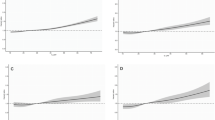Abstract
The study aimed to investigate the association between nickel exposure and the presence of diabetes (DM). The participants were analyzed from the National Health and Nutrition Examination Surveys (NHANES) 2017–2018. Urinary nickel exposure was measured using inductively coupled-plasma mass spectrometry. DM was diagnosed based on the WHO standards. The association between nickel and DM or fasting glucose was examined using multivariable linear regression models and logistic regression models. A total of 1899 participants (933 men and 966 women) were included in our study, of whom 342 (18.0%) were diagnosed with DM. There was a significant positive association between nickel level and DM (OR: 1.27, 95%CI: 1.04–1.56) after adjusting for potential confounding factors. Comparing with the lowest quartile, the highest quartile independently increased a 0.66-fold higher risk of DM (OR: 1.66, 95%CI: 1.13–2.44]). In addition, nickel exposure was independently related to the level of fasting glucose. The exposure to nickel was associated with a higher risk of DM in general population.


Similar content being viewed by others
Data Availability
The datasets were available from NHANES 2017–2018 (https://www.cdc.gov/nchs/nhanes/index.htm).
References
Guo H, Chen L, Cui H et al (2015) Research advances on pathways of nickel-induced apoptosis. Int J Mol Sci 17:10
Genchi G, Carocci A, Lauria G et al (2020) Nickel: human health and environmental toxicology. Int J Environ Res Public Health 17:679
Gauthier PT, Blewett TA, Garman ER et al (2021) Environmental risk of nickel in aquatic Arctic ecosystems. Sci. Total Environ. 797:148921
Cao Z, Mou R, Cao Z et al (2017) Nickel in milled rice (Oryza sativa L.) from the three main rice-producing regions in China. Food Addit Contam Part B Surveill 10:69–77
Bahrani B, Moghaddam N, DeKoven J (2019) Cross-sectional survey of nickel allergy management in the context of intracardiac device implantation. Dermatitis 30:213–221
Mania M, Rebeniak M, Postupolski J (2019) Food as a source of exposure to nickel. Rocz Panstw Zakl Hig 70:393–399
Fu Z, Xi S (2020) The effects of heavy metals on human metabolism. Toxicol Mech Methods 30:167–176
Li Z, Gu JY, Wang XW et al (2010) Effects of cadmium on absorption, excretion, and distribution of nickel in rats. Biol Trace Elem Res 135:211–219
Zhang Z, Chau PY, Lai HK et al (2009) A review of effects of particulate matter-associated nickel and vanadium species on cardiovascular and respiratory systems. Int J Environ Health Res 19:175–185
Tsang ACO, Nicholson P, Pereira VM (2018) Nickel-related adverse reactions in the treatment of cerebral aneurysms: a literature review. World Neurosurg 115:147–153
Bruno G, Runzo C, Cavallo-Perin P et al (2005) Incidence of type 1 and type 2 diabetes in adults aged 30–49 years: the population-based registry in the province of Turin, Italy. Diabetes Care 28:2613–2619
Perreault L, Skyler JS, Rosenstock J (2021) Novel therapies with precision mechanisms for type 2 diabetes mellitus. Nat Rev Endocrinol 17:364–377
Neel BA, Sargis RM (2011) The paradox of progress: environmental disruption of metabolism and the diabetes epidemic. Diabetes 60:1838–1848
Zota AR, Adamkiewicz G, Morello-Frosch RA (2010) Are PBDEs an environmental equity concern? Exposure disparities by socioeconomic status. Environ Sci Technol 44:5691–5692
Unal ER, Lynn T, Neidich J et al (2012) Racial disparity in maternal and fetal-cord bisphenol A concentrations. J Perinatol 32:844–850
Branch F, Woodruff TJ, Mitro SD et al (2015) Vaginal douching and racial/ethnic disparities in phthalates exposures among reproductive-aged women: National Health and Nutrition Examination Survey 2001–2004. Environ Health 14:57
James RA, Hertz-Picciotto I, Willman E et al (2002) Determinants of serum polychlorinated biphenyls and organochlorine pesticides measured in women from the child health and development study cohort, 1963–1967. Environ Health Perspect 110:617–624
Liu G, Sun L, Pan A et al (2015) Nickel exposure is associated with the prevalence of type 2 diabetes in Chinese adults. Int J Epidemiol 44:240–248
Ohashi F, Fukui Y, Takada S et al (2006) Reference values for cobalt, copper, manganese, and nickel in urine among women of the general population in Japan. Int Arch Occup Environ Health 80:117–126
Smith-Sivertsen T, Tchachtchine V, Lund E et al (1998) Urinary nickel excretion in populations living in the proximity of two russian nickel refineries: a Norwegian-Russian population-based study. Environ Health Perspect 106:503–511
Kazi TG, Afridi HI, Kazi N et al (2008) Copper, chromium, manganese, iron, nickel, and zinc levels in biological samples of diabetes mellitus patients. Biol Trace Elem Res 122:1–18
Das KK, Das SN, DasGupta S (2001) The influence of ascorbic acid on nickel-induced hepatic lipid peroxidation in rats. J Basic Clin Physiol Pharmacol 12:187–195
Gupta S, Ahmad N, Husain MM et al (2000) Involvement of nitric oxide in nickel-induced hyperglycemia in rats. Nitric Oxide 4:129–138
Chen YW, Yang CY, Huang CF et al (2009) Heavy metals, islet function and diabetes development. Islets 1:169–176
Liu CM, Ma JQ, Liu SS et al (2016) Puerarin protects mouse liver against nickel-induced oxidative stress and inflammation associated with the TLR4/p38/CREB pathway. Chem Biol Interact 243:29–34
Jimenez-Vidal L, Espitia-Perez P, Torres-Avila J et al (2019) Nuclear factor erythroid 2 - related factor 2 and its relationship with cellular response in nickel exposure: a systems biology analysis. BMC Pharmacol Toxicol 20:78
Author information
Authors and Affiliations
Contributions
D LL designed the study. S S performed the statistical analysis. W KL and H CN wrote the manuscript. All the authors read and approved the final manuscript.
Corresponding author
Ethics declarations
Ethics Approval and Consent to Participate
The study protocol was approved by NCHS Research Ethics Review Board.
Consent for Publication
Not applicable.
Competing Interests
The authors declare no competing interests.
Additional information
Publisher's Note
Springer Nature remains neutral with regard to jurisdictional claims in published maps and institutional affiliations.
Rights and permissions
About this article
Cite this article
Shan, S., Wang, K., Hu, C. et al. Urinary Nickel Was Associated with the Prevalence of Diabetes: Results from NHANES. Biol Trace Elem Res 201, 611–616 (2023). https://doi.org/10.1007/s12011-022-03190-x
Received:
Accepted:
Published:
Issue Date:
DOI: https://doi.org/10.1007/s12011-022-03190-x




